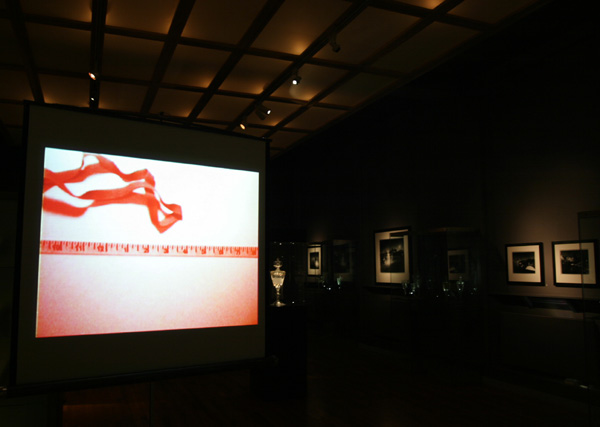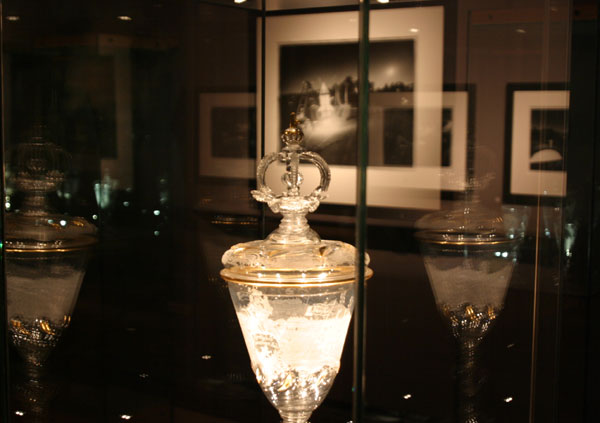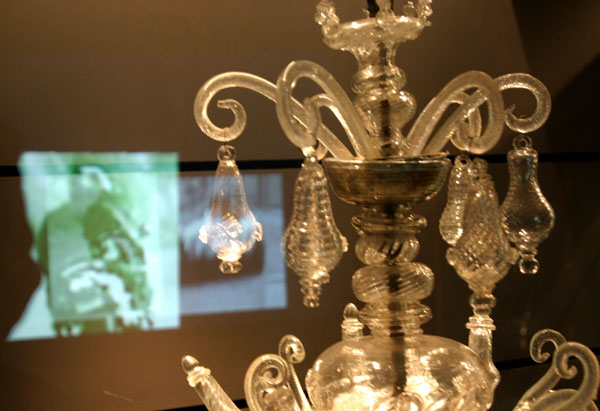Hirsch Perlman in the Nøstetangen room
The Los Angeles based artist Hirsch Perlman (b. 1960) works in several media, photography, video, sculpture and performance. For this exhibition, a group of his videos have been selected, which are shown as projections and seven photographs from recent years.
Perlman's art works within the avant-garde tradition. By that is meant artistic expression that represents emotions and values on the side of what characterizes the rational, orderly Western society. At times, the avant-garde has been aggressively critical of society, at others more puzzling, anxious and poetic. The driving force in the latter situation is to refer to other realities, things that are easy to overlook, ignore or ignore in daily life, where demands for work and active leisure take up more and more of our time and what we believe are our innermost interests. It is this latest trend that is most evident in the works shown here. But there is no comfortable, sunshine-sweet and carefree existence that is expressed. Under both the films and the photographers, a dark vein flows. And all over the place a night-dark sky stretches. Hirsch Perlman's quiet art unfolds in this dizzying space.
The videos the artist has called Affect Studies, that is, studies of what affects people and what can affect one, for better or worse. Affect is an expression of something that art is about. The motifs are something that touches and hits the artist, who in turn shapes the special experience, so that the work in turn can influence the viewer. In these films, small, everyday things are studied. There are both delicate and slowly moving moods, fast and staccato shifts and long and continuous experience zones in the films. He has selected themes and experiences that have particularly touched him and put this together with musical impressions that also mean a lot to him. In the series of short films, it alternates between classical music, country and western and improvised jazz. In two of the films, the one with the motorcycle (to music by Miles Davis Quintet) and the freight train along the horizon (to the tune of Johnny Cash), Perlman has visually processed and mediated the encounter between music and filming. We see this in the use of rectangular fields that both affect the organization of the image space and that are given a separate rhythm somewhere between music and image sequences. Hirsch Perlman has put together the films into a coherent program especially for this exhibition. What exists of notches and visual noise are random things that happened - or technical errors that occurred - during the making of the films, and something the artist has made part of their artistic expression. In the films, there is a consistent playfulness and lightness.
Perlman has taken this attitude up on the roof of his house in Los Angeles. But in works from the two series Apparatum Armorum Ineptum (which can be translated with something like: Unfit, clumsy weapon devices) and My Repfoof (My disapproval) there is a more complicated emotional state. The works are minor and melancholy. In the two large photographs (Apparatum Armorum Ineptum) we see how homemade rockets are rigged together to be sent out from the private launch pad. This is a warm and witty commentary on the efficient industry that has sent people to the moon and measuring devices far into space. There is also a humorous aspect here, for these clumsy rockets can also be seen as solid fireworks to be sent up to light up the sky and celebrate something.
A roof is a very special place to stay. And there is also undeniably something special about the fact that a man is up on the roof and making a rocket. The lonely man and the lighthouse are a charged and potentially scary combination. But the roof is also the place where one gets closer to the sky with its constellations, celestial bodies and there
one can shout out prayers, call people together, receive radio waves and TV signals, feel the wind from the sea, woods and plains or simply be able to get a little closer to one's God. The roof is also a suitable landing site for nightly visits from space. Hirsch Perlman plays on all of these associations. He himself is sometimes seen as a shadow or a blurry figure in the ceiling paintings.
The roof photographs show a place outside the well-organized and controlled side of our society. Here you can be alone, wonder, think, wait and witness something you usually spend little time on, e.g. to look at the moon and the street lights. Street lights seen from above serve little purpose, but seen as light sources, they become related to stars and illuminated planets. The photographs give a dynamic expression to all the visual impulses that can be captured on a roof one night.
As a photographic art, this is very deliberately done. Much of the joy of art is to see how the medium itself reinterprets and harmonizes different sources of influence. In these photographs we see how the grains in the film, developed positively on the photosensitive paper, interpret the darkness as black and the light as gradual intensities of white. Due to the long shutter speed, the light from the skylight, street lamps, flashlights and moon spreads out like a halo or star around the light sources and the person dissolves in the meeting between light and darkness. Everything that happens around the man on the roof is precisely modeled as an encounter between darkness and light. It is very rare in the history of black and white photography to have seen such a powerful combination of darkness and light that boils and dances around each other and becomes one context: light is still light and darkness is still dark, but they lick into each other such as the black and white fire which, according to the Kabbalah's creation account, existed before the chaos was arranged and things came to the fore as form and figure.
But this mysterious, metaphysical mood is balanced against the fact that the whole apparatus is visible. This is after all in Los Angeles, and Hollywood is not far away. The layout in the ceiling pictures is reminiscent of a film set you come across on the street by chance. Behind the camera is the technical, pragmatic chaos, the necessary equipment for the film's illusion to be created. The same ambiguity - using technique to create visual poetry - is seen in the two pictures on the end walls of the Nøstetangen room. A large, luminous, energetic electric "brain mass" on one side and a "nuclear explosion" on the other. These two photographs have an emotional explosive power that is especially experienced precariously in a room like this, with fragile, old and precisely executed ornaments. Also 18th century silver and glass required fire and a technical apparatus to be able to form. The way Perlman has made these two memorable pictures is by fooling long chains with small Christmas tree candles into rolled-up plastic. The electric light is reunited with its cosmic origin and the banal is transformed into something of high value.
Hirsch Perlman is a graduate of Yale University and has exhibited at a number of renowned galleries and museums. Since 1987, he has held almost 30 solo exhibitions. He exhibits at discerning galleries such as Feature in New York, Donald Young in Chicago and Los Angeles, Monika Sprüth in Cologne and Gimpel Fils in London. He has exhibited separately at the Museum of Modern Art in New York, in their prestigious project drum program (1996), at the Shedhalle in Zurich (1990) and The Renaissance Society in Chicago (1988). Of many curated group exhibitions, his two appearances at the Whitney Biennale (1989 and 2002) and the important exhibition Play of the Unsayable are mentioned; Wittgenstein and the Art of the 20th Century, in Wiener Secession in 1990. - This is the first time Hirsch Perlman has exhibited in Norway.
Åsmund Thorkildsen
Museum director





